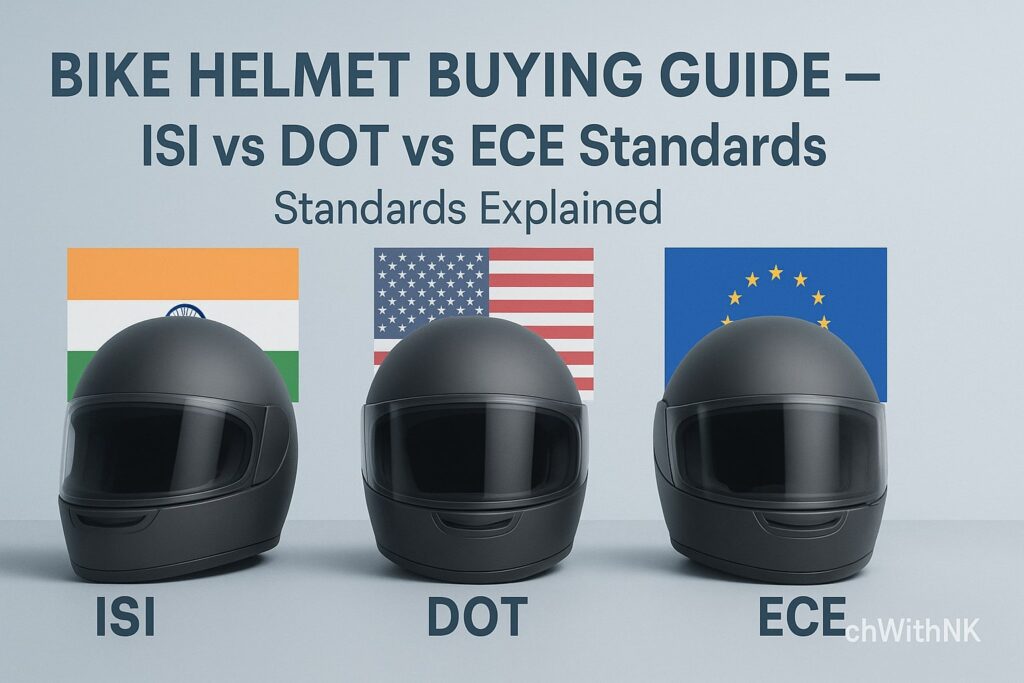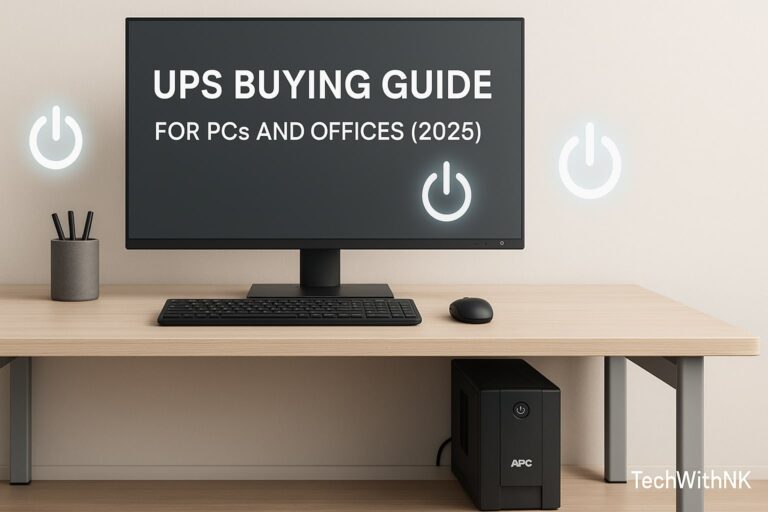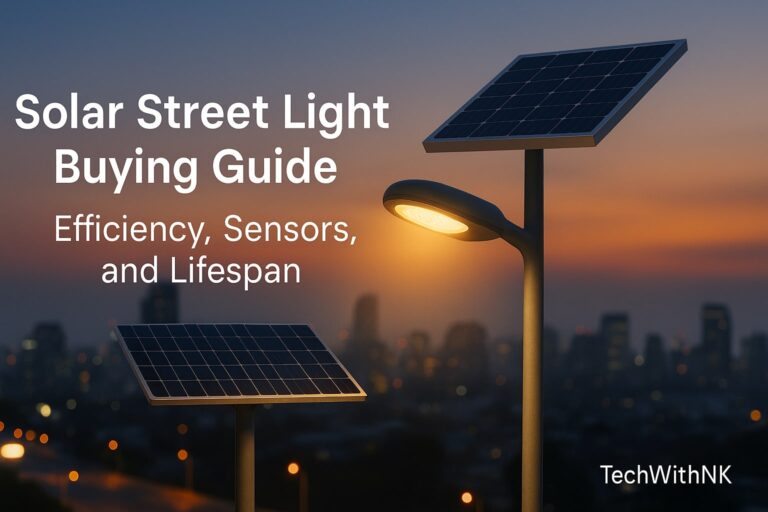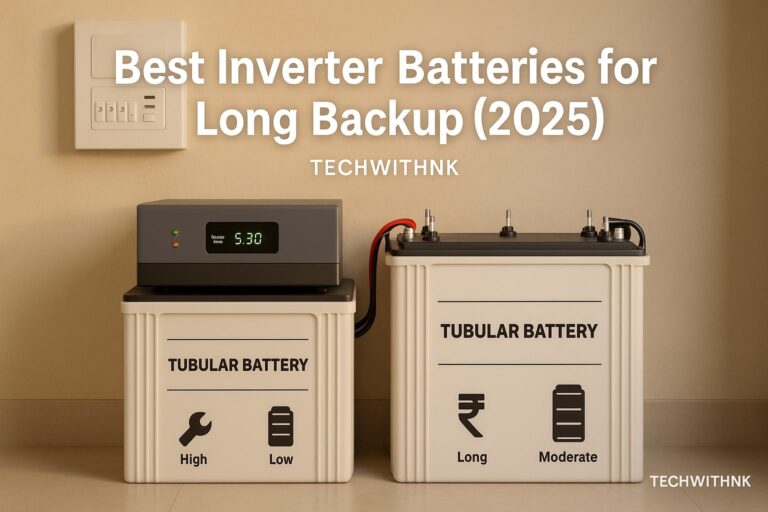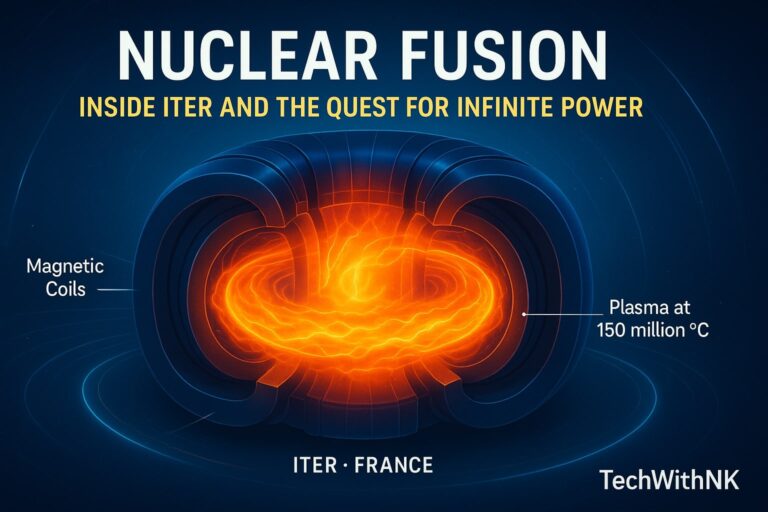Bike helmet buying guide:Why a Helmet Is More Than Just Gear
Every year, thousands of motorcyclists lose their lives in road accidents—many due to not wearing a proper helmet. A helmet isn’t just a legal requirement—it’s your first line of defense against head injuries.
But when you walk into a showroom, you’ll find helmets with different safety markings — ISI, DOT, ECE, SNELL, etc. Which one should you choose? What do these certifications even mean?
This comprehensive TechWithNK guide explains everything — from safety standards and helmet types to fit, materials, ventilation, and tips for Indian riders.
Understanding Helmet Safety Standards
Before buying, you must understand what ISI, DOT, and ECE mean — because your life depends on these standards.
ISI – Indian Standard (BIS IS:4151)
ISI Mark: The Indian Standards Institute mark is issued by Bureau of Indian Standards (BIS).
All helmets sold in India must comply with IS:4151, as per CMVR (Central Motor Vehicle Rules).
Key Features:
Mandatory for helmets sold in India.
Tests include impact absorption, penetration resistance, retention system strength, and field of vision.
Typically uses a single impact test.
The testing is done on fixed-speed impacts at specific points.
Pros:
✅ Legal for Indian roads
✅ Affordable helmets available with ISI
✅ Basic protection for low-speed urban commuting
Cons:
❌ Lower impact testing speed (compared to DOT/ECE)
❌ Often misused by fake ISI stickers
❌ Not ideal for high-speed or racing use
How to Verify Genuine ISI:
Check the 7-digit CM/L number under the ISI logo.
Visit the official BIS website and verify the number.
Avoid helmets with printed or peel-off ISI stickers — genuine ones are engraved or laser-marked.
DOT – U.S. Department of Transportation (FMVSS 218)
DOT Standard: Federal Motor Vehicle Safety Standard (FMVSS 218), managed by the U.S. Department of Transportation.
Key Features:
Used for helmets sold in the USA.
Designed to protect riders in high-speed highway conditions.
Tests include impact absorption, penetration, retention, and peripheral vision.
Tests are done at higher impact speeds and across multiple surfaces (flat and curved anvils).
Pros:
✅ Stronger impact tests than ISI
✅ Suitable for highway riding and touring
✅ Reliable certification with strict guidelines
Cons:
❌ Not officially recognized for Indian road compliance (unless dual-certified)
❌ Heavier due to thicker shell design
Tip:
If you’re an Indian rider who tours or rides superbikes, a dual-certified (DOT + ECE) helmet is a great choice.
ECE – Economic Commission for Europe (ECE 22.05 / 22.06)
ECE Certification: Issued by the United Nations Economic Commission for Europe.
Used in over 50 countries, including Europe, Japan, and parts of Asia.
Key Features:
Most globally accepted standard.
Tests include impact, abrasion, strap strength, visor clarity, and rotational acceleration.
Newest version ECE 22.06 adds rotational impact tests (similar to MIPS systems).
Tests multiple samples, not just one — ensuring consistency.
Pros:
✅ Globally recognized and accepted in racing
✅ Tested on multiple helmets per batch
✅ Covers rotational impact (22.06 version)
✅ Lightweight but very safe
Cons:
❌ Expensive (imported helmets)
❌ Not always easy to verify authenticity
🧠 Comparison Table: ISI vs DOT vs ECE Helmets
| Feature / Standard | ISI (India) | DOT (USA) | ECE (Europe) |
|---|---|---|---|
| Governing Body | BIS | U.S. DOT | UNECE |
| Legal in India | ✅ | ❌ (unless dual certified) | ❌ (unless dual certified) |
| Impact Speed Tested | 27 km/h | 48 km/h | 50–60 km/h |
| Multi-Impact Test | ❌ | ✅ | ✅ |
| Visor Testing | Basic | Yes | Yes |
| Rotational Impact | ❌ | Partial | ✅ (22.06) |
| Weight Range | Light | Moderate | Light |
| Ideal Use | City commute | Touring | Racing/All-round |
| Cost Range (₹) | ₹800–₹2,500 | ₹3,000–₹8,000 | ₹5,000–₹20,000+ |
Helmet Types Explained
Choosing a helmet is not just about standards — design and purpose matter too.
1. Full-Face Helmet
Best all-round protection (chin + skull + jaw).
Ideal for highways and long rides.
Example: Axor Apex Venomous (DOT + ECE certified).
2. Modular / Flip-Up Helmet
Chin section can lift up for convenience.
Slightly heavier but practical for touring.
Some are dual certified (P/J) for open and closed mode.
3. Half-Face / Open-Face Helmet
Covers top and sides of the head.
More ventilation, less protection.
Suitable for scooter or city commuting.
4. Off-Road / Dual-Sport Helmet
Designed for motocross and adventure biking.
Extended chin guard and visor peak.
Combine with goggles for off-road riding.
Helmet Construction & Materials
The protection quality also depends on the shell and liner materials.
| Component | Function | Common Materials |
|---|---|---|
| Outer Shell | Distributes impact force | ABS, Polycarbonate, Fiberglass, Carbon Fiber |
| EPS Liner | Absorbs shock | Expanded Polystyrene foam |
| Comfort Padding | Fit and comfort | Foam, Fabric, Antimicrobial liners |
| Retention Strap | Keeps helmet secure | Nylon with D-ring or micrometric buckle |
| Visor | Eye protection | Polycarbonate, UV coated |
Pro Tip: Avoid helmets made only of ABS plastic if you ride above 60–70 km/h regularly. Go for fiberglass composite or carbon fiber for stronger impact resistance.
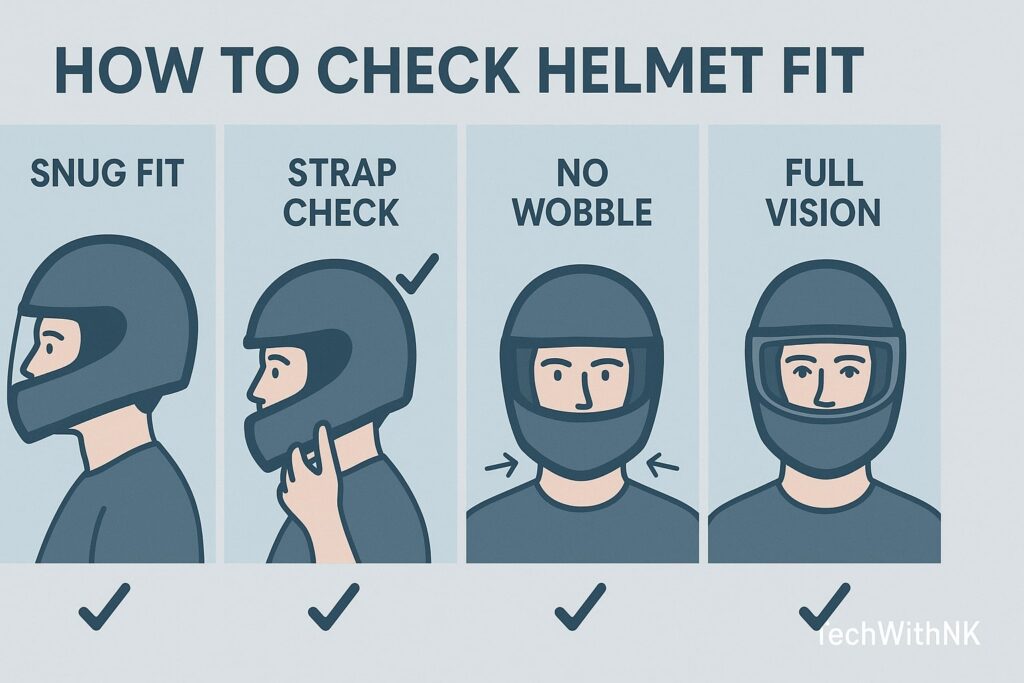
Fit, Comfort & Ventilation
A helmet’s safety is useless if it doesn’t fit properly.
✅ Check These Before Buying:
Tight Fit: Should be snug but not painful.
No Movement: Shake your head—helmet shouldn’t wobble.
Chin Strap: You should fit two fingers under it.
Vision: Should provide at least 210° peripheral view.
Ventilation: Look for front, top, and rear vents for air circulation.
Helmet Sizing Chart (General)
| Head Circumference | Helmet Size |
|---|---|
| 53–54 cm | XS |
| 55–56 cm | S |
| 57–58 cm | M |
| 59–60 cm | L |
| 61–62 cm | XL |
Legal Rules for Helmets in India (2025)
✅ Indian Helmet Rules:
Helmets must have ISI certification (IS:4151).
Helmets weighing over 1.2 kg are not allowed for sale (BIS rule).
BIS & MoRTH made ISI mandatory for all helmets sold in India since 2021.
Penalty for non-compliance: ₹1,000 fine + license suspension (as per Motor Vehicles Act, Section 129).
But Can You Use DOT or ECE Helmets in India?
Yes — only if they also have ISI mark or dual certification.
Many premium brands like Axor, SMK, MT, LS2, Arai, AGV, and Shoei now sell ISI + DOT/ECE certified helmets for Indian riders.
Helmet Safety Features to Look For
| Feature | Why It Matters |
|---|---|
| Dual Visor (sun + clear) | Reduces glare in daytime |
| Pinlock Ready | Prevents fogging |
| Quick Release Strap | Easier to remove in emergency |
| Reflective Strips | Improves night visibility |
| MIPS Technology | Reduces rotational brain injury |
| Aerodynamic Spoiler | Improves stability at high speeds |
Price Segments & Top Recommendations (2025)
| Price Range | Example Helmets | Certification |
|---|---|---|
| ₹1,000–₹2,500 | Studds, Steelbird, Vega | ISI |
| ₹3,000–₹6,000 | Axor, SMK, MT | ISI + DOT |
| ₹6,000–₹12,000 | LS2, MT Thunder, Axor Apex | DOT + ECE |
| ₹12,000–₹30,000+ | AGV, Shoei, Arai | ECE / SNELL |
Common Myths About Helmets
| Myth | Reality |
|---|---|
| “ISI helmets are bad.” | They are fine for city use; just ensure genuine certification. |
| “Expensive helmets are just for looks.” | Higher cost = better materials + safety standards. |
| “Loose helmets are comfortable.” | Loose helmets can slip off during impact. |
| “Open-face helmets are fine for all rides.” | They don’t protect your chin or jaw. |
Helmet Maintenance & Replacement
🧼 Maintenance Tips:
Clean visor with microfiber cloth and mild soap.
Don’t expose to direct sunlight for long durations.
Avoid hanging helmets on mirrors — it damages inner foam.
Replace worn padding and visors regularly.
🔁 When to Replace:
After any crash or drop (even minor).
Every 3–5 years due to material degradation.
Bonus – SNELL and FIM Standards (Advanced Riders)
SNELL:
Voluntary certification by Snell Memorial Foundation (USA).
Tests at higher G-forces than DOT or ECE.
Popular among racers (e.g., Shoei X-Fourteen).
FIM:
Federation Internationale de Motocyclisme – for MotoGP-level helmets.
Newest and most advanced standard.
🏁 Conclusion: Choose Safety, Not Style
A helmet is not an accessory—it’s survival gear.
Choose one that fits you perfectly, carries genuine certification, and matches your riding needs.
For Indian riders:
City riders: ISI or ISI+DOT
Touring / superbike riders: ECE or DOT + ECE
Track / professional riders: SNELL or FIM
Remember, your head deserves the best protection you can afford — not just the cheapest.
